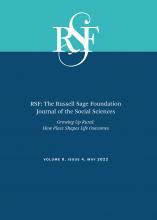Research Article
Open Access
We Won’t Be Able to Find Jobs Here: How Growing Up in Rural America Shapes Decisions About Work
Ashley R. Niccolai, Sarah Damaske, Jason Park
RSF: The Russell Sage Foundation Journal of the Social Sciences May 2022, 8 (4) 87-104; DOI: https://doi.org/10.7758/RSF.2022.8.4.04
Ashley R. Niccolai
aCompleted her doctoral candidacy exams at The Pennsylvania State University, United States
Sarah Damaske
bAssociate professor of sociology and labor and employment relations at The Pennsylvania State University, United States
Jason Park
cGraduate student in sociology at The Pennsylvania State University, United States

REFERENCES
- ↵
- ↵
- Bernsen, Nicole R.,
- Mindy S. Crandall,
- Jessica E. Leahy, and
- Catharine Biddle
- ↵
- Bettie, Julie
- ↵
- Brown, David L., and
- Kai A. Schafft
- ↵
- Brown, Sherlon P
- ↵
- ↵
- Byun, Soo-yong,
- Judith L. Meece,
- Matthew J. Irvin, and
- Bryan C. Hutchins
- ↵
- Carr, Patrick J., and
- Maria J. Kefalas
- ↵
- ↵
- Center for Rural Pennsylvania
- ↵
- ↵
- Conley, Dalton
- ↵
- Correll, Shelley J
- ↵
- Cottom, Tressie McMillan
- ↵
- Cushing, Brian
- ↵
- Damaske, Sarah
- ↵
- Damaske, Sarah
- ↵
- Damaske, Sarah
- ↵
- ↵
- Dannefer, Dale
- ↵
- ↵
- DiPrete, Thomas A., and
- Claudia Buchmann
- ↵
- Drescher, Jessica,
- Anne Podolsky,
- Sean F. Reardon, and
- Gabrielle Torrance
- ↵
- Dwyer, Rachel E.,
- Randy Hodson, and
- Laura McCloud
- ↵
- Elder, Glenn H., Jr.
- ↵
- ↵
- Francis, Robert D
- ↵
- Frech, Adrianne, and
- Sarah Damaske
- ↵
- Garey, Anita Ilta
- ↵
- Gerson, Kathleen, and
- Sarah Damaske
- ↵
- Gibbs, Robert M., and
- John B. Cromartie
- ↵
- Hardie, Jessica Halliday
- ↵
- Holland, Megan M
- ↵
- Israel, Glenn D.,
- Lionel J. Beaulieu, and
- Glenn Hartless
- ↵
- Johnson, Jennifer
- ↵
- Khattri, Nidhi,
- Kevin W. Riley, and
- Michael B. Kane
- ↵
- Lareau, Annette
- ↵
- Lippert, Adam M., and
- Sarah A. Damaske
- ↵
- Lips, Hilary M
- ↵
- Machung, Anne
- ↵
- Marcus, Jon, and
- Matt Krupnick
- ↵
- Mills, Bradford, and
- Gautam Hazarika
- ↵
- Moen, Phyllis, and
- Shin-Kap Han
- ↵
- ↵
- ↵
- Nelson, Ingrid A
- ↵
- Newman, Katherine S
- ↵
- ↵
- Parsons, Ryan
- ↵
- ↵
- Provasnik, Stephen,
- Angelina KewelRamani,
- Mary McLaughlin Coleman,
- Lauren Gilbertson,
- Will Herring, and
- Qingshu Xie
- ↵
- Ray, Ranita
- ↵
- Rohall, David E.,
- Melissa A. Milkie, and
- Jeffrey W. Lucas
- ↵
- Schafft, Kai A., and
- Alecia Youngblood Jackson
- ↵
- Schell, Kait Smeraldo, and
- Jennifer M. Silva
- ↵
- Schulz, Jeremy, and
- Laura Robinson
- ↵
- Sherman, Jennifer
- ↵
- Silva, Jennifer M
- ↵
- Snyder, Thomas D.,
- Cristobel de Brey, and
- Sally A. Dillow
- ↵
- Swauger, Melissa L
- ↵
- Turley, Ruth N. L
- ↵
- Vazzana, Caryn M., and
- Jeta Rudi-Polloshka
- ↵
- Vespa, Jonathan
- Wells, Bettie L
- ↵
- Wells, Ryan S.,
- Catherine A. Manly,
- Suzan Kommers, and
- Ezekiel Kimball
- ↵
- Williams, Sonya and
- Shin-Kap Han
- ↵
- Willis, Paul E
- ↵
- ↵
- Wong, Jaclyn S
In this issue
We Won’t Be Able to Find Jobs Here: How Growing Up in Rural America Shapes Decisions About Work
Ashley R. Niccolai, Sarah Damaske, Jason Park
RSF: The Russell Sage Foundation Journal of the Social Sciences May 2022, 8 (4) 87-104; DOI: 10.7758/RSF.2022.8.4.04
Jump to section
Related Articles
- No related articles found.
Cited By...
- No citing articles found.





